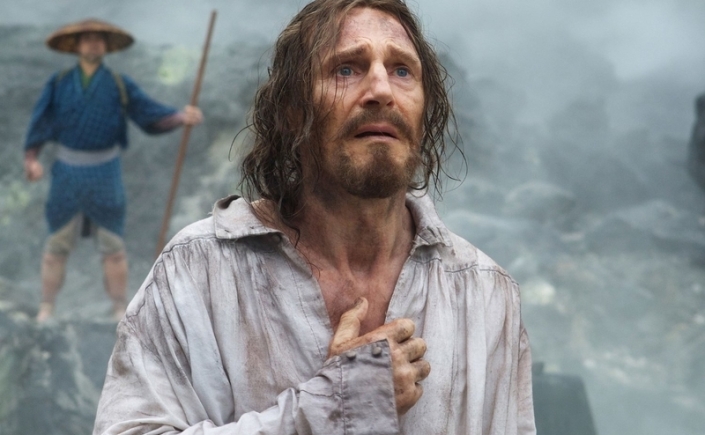 Director: Martin Scorsese
Director: Martin Scorsese
Starring: Andrew Garfield, Adam Driver, Tadanobu Asano, Ciarán Hinds, Liam Neeson
The world is not short on stories in which faith is tested. Yet “Silence” is a Scorsese – so naturally, it’s done so well that the movie feels like a brand new story. This specific trial of faith happens for two Jesuit missionaries who face dangerous persecution in seventeenth century Japan. With questions of faith and brutal depictions of violence, both of which are favorites of Scorsese, it’s clear that he’s not trying to reinvent the wheel. Still, he knows what he’s doing and does it well, gifting us with a film that is well paced and makes great use of imagery and symbolism to tackle a difficult theme.
In Japan, the seventeenth century was known as the Edo period, a time in which the shogunate in power had instilled a strict isolationist foreign policy and persecution against Christians. When two Portuguese Jesuit priests, Father Sebastiao Rodrigues (Andrew Garfield) and Father Francisco Garupe (Adam Driver), learn that their teacher Father Ferreira (Liam Neeson) has renounced his faith while doing missionary work in Japan, they are filled with disbelief. Although the priest who delivered the message to them is certain of Ferreira’s abandonment, Rodrigues and Garupe declare it false without proof. Determined to find Ferreira to prove that he is either alive and imprisoned or dead as a martyr, the pair of them set off on a dangerous journey to Japan. In order to enter the country, the priests seek a guide in China, and they find a washed up drunk named Kichijiro (Yosuke Kobozuka). Despite their skepticism about his ability to actually take them into Japan, Rodrigues and Garupe soon find themselves in a small Japanese village filled with hidden Christians.

One of the noticeable things about “Silence” is the intriguing characters and the way they juxtapose and shape one another. Scorsese has written wonderfully substantial agents, who are complemented by a talented cast that brings them to life. Garfield’s Father Rodrigues is the most obvious example, because although the priests set out together, “Silence” is clearly Rodrigues’s story. He narrates events initially through letters to his compatriots in Portugal, and later in his prayers. His devotion to Catholicism and kindness are shown by his eagerness to help the hidden Christians in the Japanese village. When the villagers first meet the two priests (who are a dangerous rarity), they are awestruck and react as though it’s an affirmation of their faith in Catholicism. Rodrigues is utterly moved by the ways in which these people have been able to maintain their belief, even in the desolate environment that holds such deadly hostility for Christians. This is clear both through the dialogue of his written reflections and through Garfield’s performance, but his humbled reaction deceives us. In actuality, Rodrigues is self-righteously filled with the holier-than-thou goodness that he believes of himself, which is something that the other characters explore and allow us to see. Kichijiro allows us to measure the changing or stagnant strength of Rodrigues’s faith, and he himself is an anomaly. The bottom line is that each character has a place in Rodrigues’s development and vision of himself, but they still stand on their own.
On the controversial side of “Silence” is the fact that the film begins by asking viewers to sympathize with missionaries. What missionaries call “spreading the good news of Christ,” others may call being “arrogant and intolerant to other religions and cultures.” Given that I was brought up in Judaism, a religion that does  not subscribe to this practice, I tend to agree with the “others” in that debate. That being said, if Silence were a film that purely sympathized with Father Rodrigues, the movie wouldn’t be nearly as good as it is. Instead, Scorsese includes doubts about whether the Jesuits’ mission in Japan is morally right, by including the Japanese perspective which he does through the fearsome character of the Inquisitor. It’s evident when a director believes that their protagonist is clearly in the right, because he doesn’t entertain the idea that there may be a gray area (take “Harry Potter” for instance). “Silence” doesn’t make the mistake of assuming things are so black and white, in fact we get to see each side argue his part. The Inquisitor, played in a fantastic performance from Issey Ogata, is the feared enforcer of the ban on Christianity and responsible for horrific torture of hidden Christians. He also serves as the voice of the Japanese argument against allowing Christianity into the country, and even engages Father Rodrigues in quite the extensive dialogue arguing their opposing views. Despite seeing all of the cruel things that the Inquisitor instigates, at some point or another during their arguments, we end up acknowledging that the Japanese viewpoint has merit.
not subscribe to this practice, I tend to agree with the “others” in that debate. That being said, if Silence were a film that purely sympathized with Father Rodrigues, the movie wouldn’t be nearly as good as it is. Instead, Scorsese includes doubts about whether the Jesuits’ mission in Japan is morally right, by including the Japanese perspective which he does through the fearsome character of the Inquisitor. It’s evident when a director believes that their protagonist is clearly in the right, because he doesn’t entertain the idea that there may be a gray area (take “Harry Potter” for instance). “Silence” doesn’t make the mistake of assuming things are so black and white, in fact we get to see each side argue his part. The Inquisitor, played in a fantastic performance from Issey Ogata, is the feared enforcer of the ban on Christianity and responsible for horrific torture of hidden Christians. He also serves as the voice of the Japanese argument against allowing Christianity into the country, and even engages Father Rodrigues in quite the extensive dialogue arguing their opposing views. Despite seeing all of the cruel things that the Inquisitor instigates, at some point or another during their arguments, we end up acknowledging that the Japanese viewpoint has merit.



Great review!
Really looking forward to watching this tomorrow now.
LikeLiked by 1 person
Hope you enjoy it!
LikeLiked by 1 person
So good but so tough!
LikeLike
[…] Such is the case with Reel Red Reviews and her take on Martin Scorsese’s Silence (2016) https://reelredreviews.net/2017/01/18/silence-2016/ […]
LikeLike
This sounds really good. I am looking forward to watching the movie 🙂
LikeLiked by 1 person